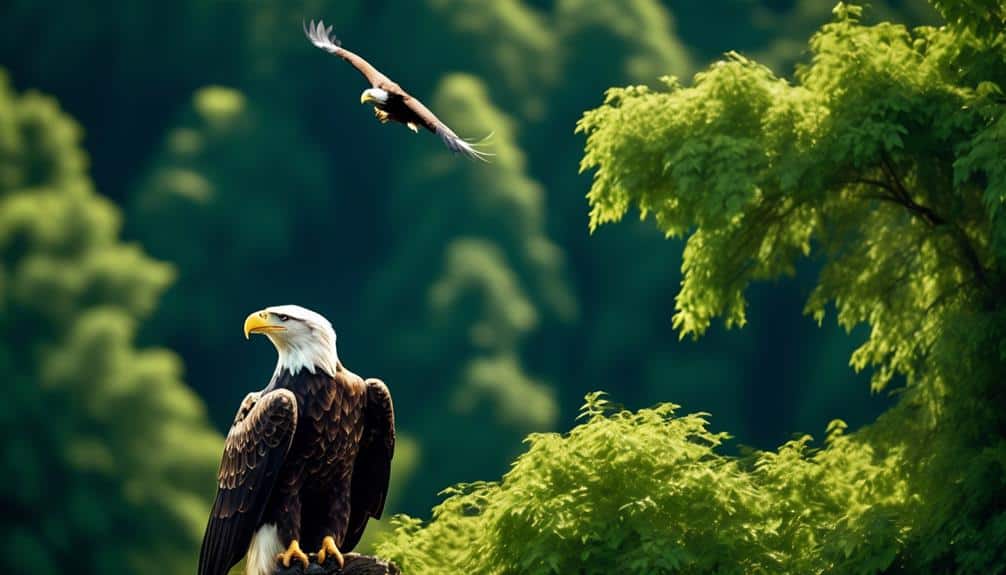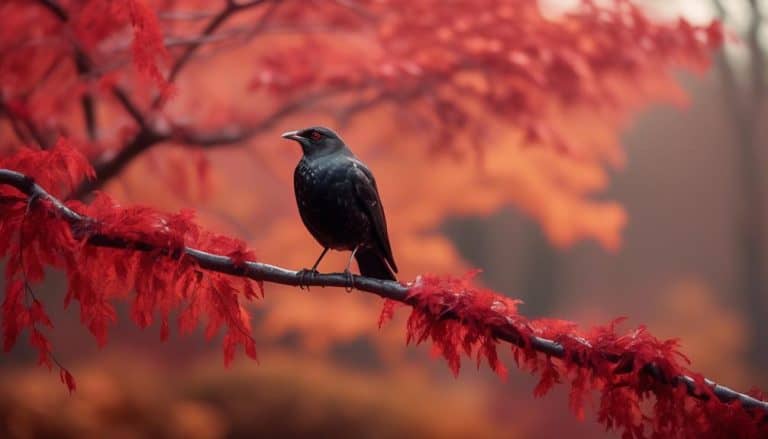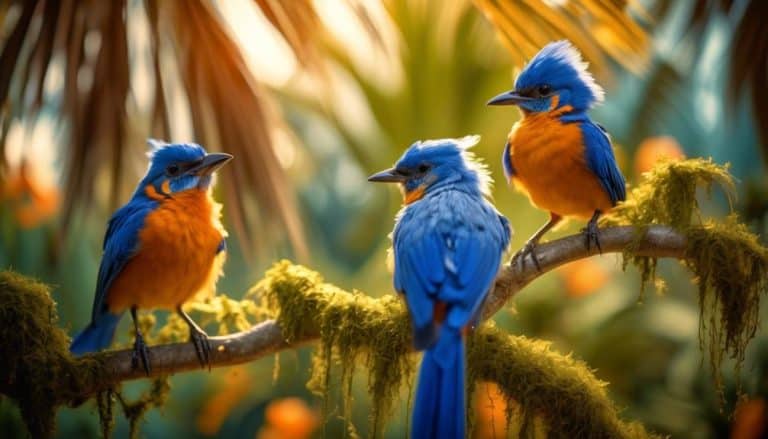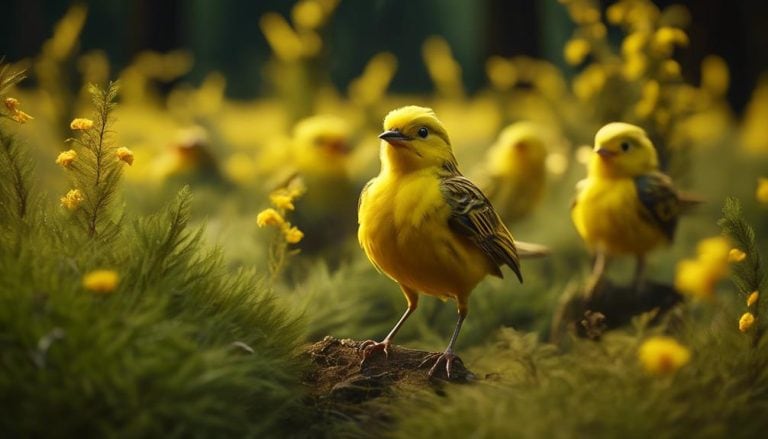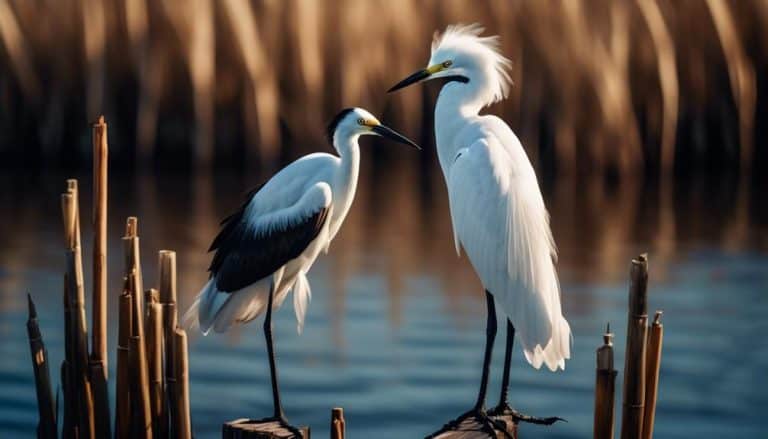As I stood on the banks of the serene Chesapeake Bay, my eyes were drawn to the sky above, where a magnificent ballet of wings unfolded.
Virginia, a land of abundant natural wonders, is home to a diverse array of large birds that grace our skies with their presence.
From the regal bald eagle soaring with unwavering purpose to the elegant great blue heron gliding gracefully, these majestic creatures captivate our imagination and remind us of the untamed beauty that surrounds us.
But there is more to these avian inhabitants than meets the eye, and as I discovered, their stories are as captivating as their flights.
The Majestic Bald Eagle
The Majestic Bald Eagle, with its impressive wingspan and iconic white head, is a prominent and revered bird species found in Virginia. With its strong conservation efforts, the bald eagle population has seen significant growth and expanded distribution in recent years.
Bald eagle conservation efforts in Virginia have been vital in ensuring the survival and recovery of this iconic species. Due to habitat loss, pollution, and hunting, the bald eagle population had declined drastically in the past. However, thanks to dedicated conservation programs, such as habitat protection, nest monitoring, and anti-poaching measures, the population has rebounded.
The growth of the bald eagle population in Virginia is a testament to the success of these conservation efforts. Since the 1970s, when the species was listed as endangered, the population has steadily increased. In fact, according to the Virginia Department of Wildlife Resources, there are now over 1,000 breeding pairs of bald eagles in the state.
The distribution of bald eagles in Virginia has also expanded as a result of conservation efforts. Once limited to coastal areas and large rivers, bald eagles can now be found throughout the state. They've adapted to various habitats, including lakes, reservoirs, and even urban areas, where they build their nests on tall structures like cell towers and power lines.
The Graceful Great Blue Heron
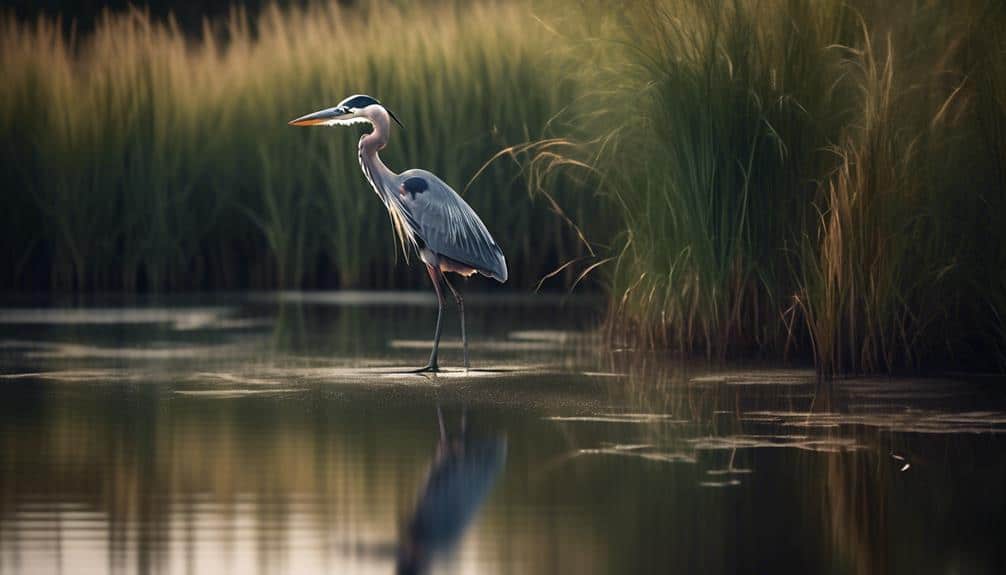
Having discussed the remarkable recovery of the bald eagle population in Virginia, it's now time to shift our focus to another magnificent bird species found in the state – the graceful great blue heron.
Majestic in flight: Watching a great blue heron take flight is a breathtaking sight. With its wide wingspan reaching up to six feet, it effortlessly soars through the sky, its long, slender neck extended gracefully.
Patient hunter: The great blue heron is known for its patient hunting behavior. It stands motionless in the shallow water of marshes, lakes, and rivers, waiting for the perfect moment to strike. With lightning-fast reflexes, it plunges its sharp beak into the water to catch fish, frogs, and even small mammals.
Habitat preference: These elegant birds prefer wetland habitats such as swamps, marshes, and estuaries. They can also be found near rivers, lakes, and coastal areas. The great blue heron builds its nests in tall trees near water, allowing easy access to their hunting grounds.
Great blue herons aren't only beautiful to behold, but they also play a vital role in maintaining the balance of ecosystems. By controlling the population of aquatic creatures, they contribute to the health and diversity of their habitats.
The Striking Red-tailed Hawk
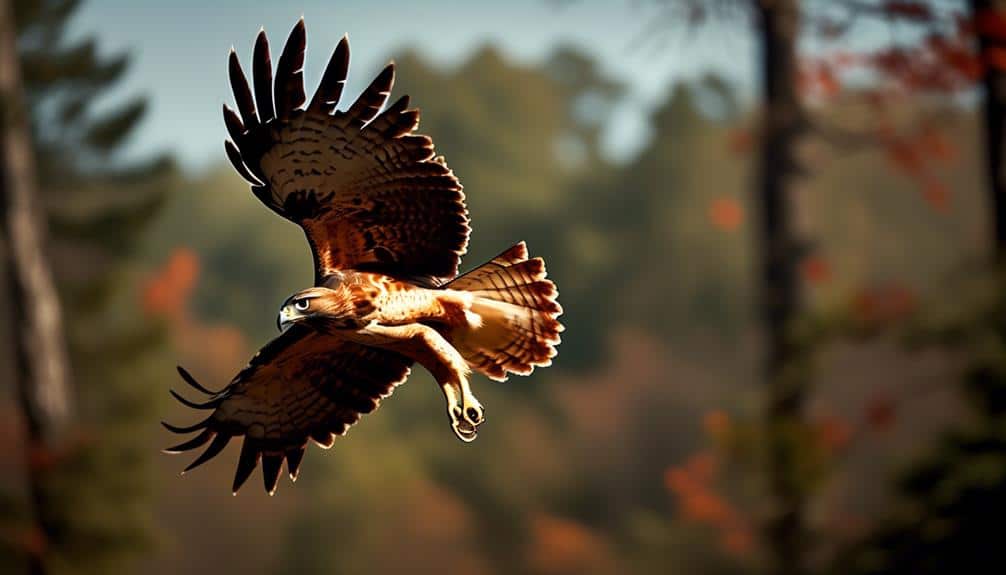
With its piercing gaze and majestic wingspan, the red-tailed hawk is a striking bird of prey found in the state of Virginia. Known for its reddish-brown tail feathers, this formidable predator possesses a range of physical characteristics and hunting habits that make it a fascinating species to observe.
The red-tailed hawk is a large raptor, typically measuring between 18 to 26 inches in length and weighing around 2 to 4 pounds. Its wingspan can reach an impressive 3 to 4 feet, allowing it to soar effortlessly through the skies. Its most distinguishing feature, as its name suggests, is its red tail feathers, which are often visible during flight.
Equipped with sharp talons and a hooked beak, the red-tailed hawk is a skilled hunter. It primarily feeds on small mammals such as mice, rabbits, and squirrels. With its keen eyesight, it can spot prey from high altitudes and dive down with incredible speed and accuracy to catch its target. This bird of prey also possesses excellent hearing, enabling it to locate prey hidden in tall grass or underbrush.
To engage the audience, let's explore a comparison table highlighting the physical characteristics and hunting habits of the red-tailed hawk:
| Physical Characteristics | Hunting Habits |
|---|---|
| Large size | Spotting prey from afar |
| Reddish-brown tail feathers | Diving down with speed and accuracy |
| Impressive wingspan | Feeding on small mammals |
| Sharp talons and hooked beak | Excellent eyesight and hearing |
The Beautiful American White Pelican
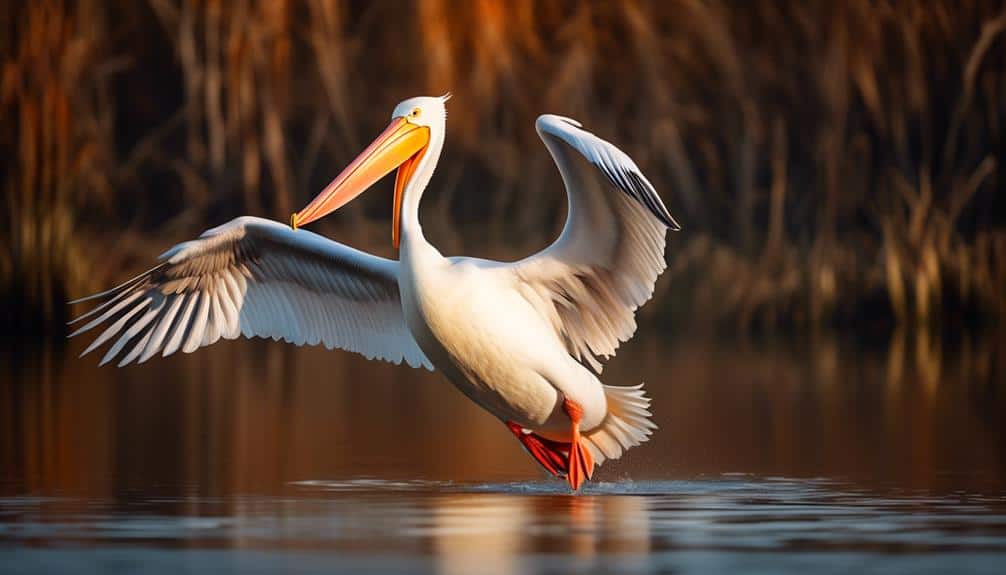
Nestled along the waterways of Virginia, the American White Pelican is a magnificent sight to behold with its impressive wingspan and striking white plumage. As a bird enthusiast, I'm captivated by the beauty and grace of this species.
Here are three remarkable aspects of the American White Pelican:
- Endangered Status: Despite its stunning appearance, the American White Pelican faces the threat of endangerment. Loss of habitat, pollution, and human disturbance have contributed to the decline in its population. It's crucial that we take proactive measures to protect and conserve this majestic bird.
- Feeding Habits: The American White Pelican is a skilled forager, using a unique feeding technique known as 'cooperative fishing.' They gather in groups and swim together to corral fish into shallow waters. With their bills open wide, they scoop up fish and water, allowing the water to drain out before swallowing their meal.
- Impressive Size: This pelican species is one of the largest birds in North America, measuring up to six feet in wingspan. With such grand proportions, it's no wonder that the American White Pelican commands attention wherever it goes.
The Impressive Sandhill Crane
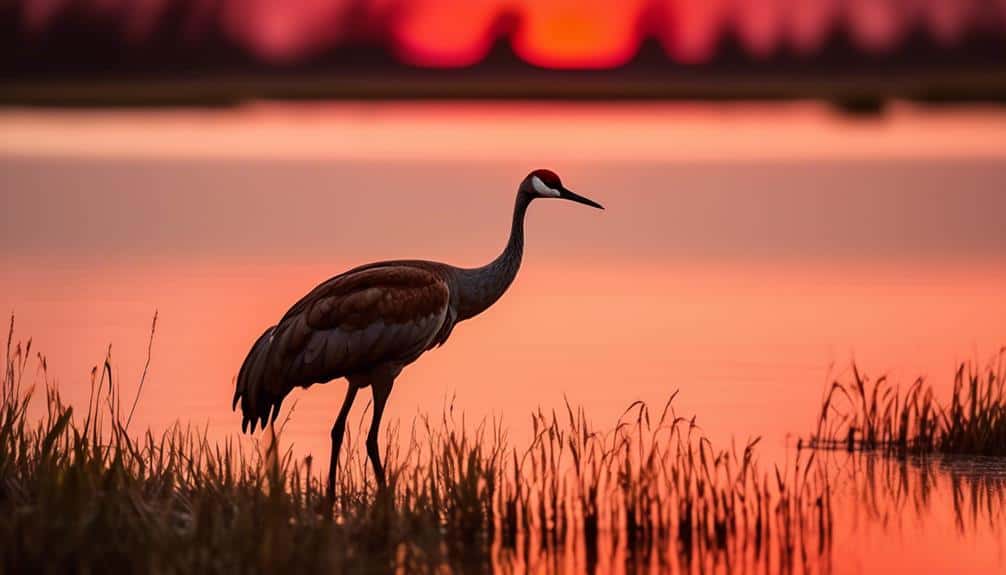
The Sandhill Crane, an impressive bird species found in Virginia, stands tall with its striking appearance and fascinating behaviors. These large birds are known for their distinctive red crowns, long legs, and impressive wingspan of up to seven feet. Sandhill Cranes are highly social birds, often seen in large flocks during both migration and breeding seasons. They communicate through a variety of calls, including a distinctive bugling sound that carries over long distances.
Sandhill Crane behavior is particularly intriguing during their courtship displays. Mates engage in elaborate dances, leaping and bowing with outstretched wings. These displays not only strengthen the pair bond but also serve as a means of defending their territory. Once paired, Sandhill Cranes build nests on the ground, using vegetation and other materials. Both parents take turns incubating the eggs, and after hatching, they diligently care for their young.
Conservation efforts for Sandhill Cranes have been successful in Virginia. The species has rebounded from historical population declines, thanks to habitat protection and management programs. Wetlands restoration projects have provided crucial breeding grounds and stopover sites for migrating cranes. Additionally, public education and awareness campaigns have helped promote the importance of conserving these magnificent birds.
The Colorful Wood Duck
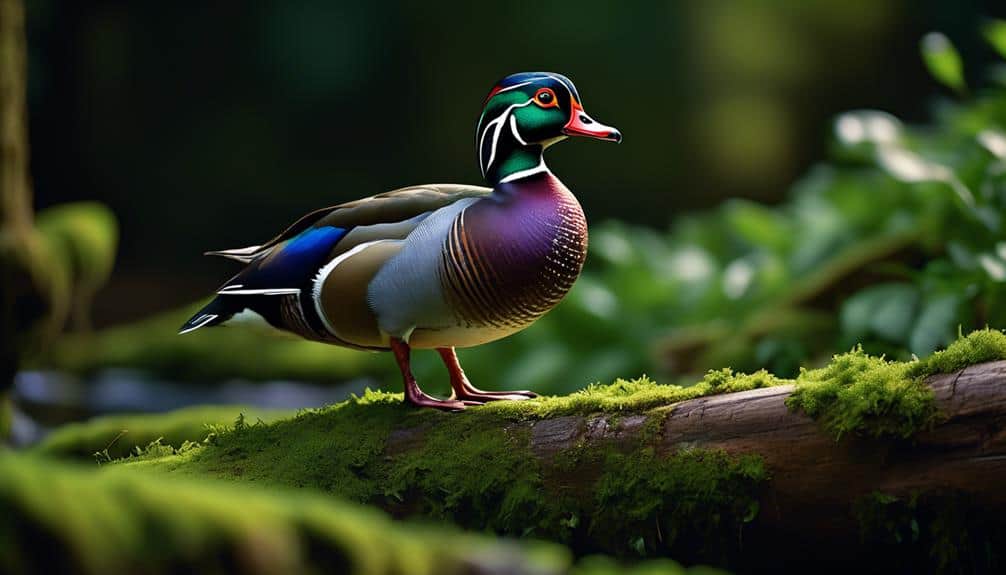
The Colorful Wood Duck, known for its vibrant plumage and unique breeding habits, is a captivating bird species found in Virginia. With its stunning array of colors, including shades of green, blue, and purple, the male wood duck is often considered one of the most beautiful ducks in North America. Its iridescent feathers shimmer in the sunlight, creating a mesmerizing sight.
Here are three fascinating facts about the Colorful Wood Duck:
- Elaborate Courtship Displays: During the breeding season, male wood ducks perform elaborate courtship displays to attract females. They stretch their necks, bob their heads, and emit soft whistling calls. This striking behavior showcases the male's vibrant plumage and demonstrates his fitness as a potential mate.
- Unique Nesting Habits: Wood ducks are cavity nesters, meaning they nest in tree hollows or man-made nest boxes. The female selects a suitable nesting site, often near water, and lines the nest with down feathers for insulation. This nesting behavior helps protect the eggs and ducklings from predators.
- Precocious Ducklings: Unlike many other duck species, wood duck ducklings are capable of leaving the nest just hours after hatching. They're known as precocial, meaning they're relatively independent and can swim and forage for food on their own from an early age. This adaptability ensures their survival in their natural habitat.
The Colorful Wood Duck is a true marvel of nature, with its stunning plumage and fascinating breeding habits. Its presence in Virginia adds vibrancy and beauty to the state's diverse bird population.
Frequently Asked Questions
Are Large Birds in Virginia Protected by Law?
Yes, large birds in Virginia are protected by law. Large bird conservation and bird population management are important aspects of wildlife management in the state.
What Is the Average Lifespan of the Majestic Bald Eagle?
On average, the majestic bald eagle has a lifespan of 20 to 30 years. This magnificent bird, with its impressive wingspan and piercing gaze, graces the skies with its presence for decades.
How Does the Graceful Great Blue Heron Catch Its Prey?
I observe that the great blue heron employs graceful hunting techniques and various prey capture methods. It uses its long legs to wade through shallow water, swiftly striking at fish and other small aquatic creatures with its sharp beak.
What Are the Habitat Preferences of the Striking Red-Tailed Hawk?
The red-tailed hawk, a magnificent bird, has specific habitat preferences for nesting. It can be found in a variety of habitats, such as forests, grasslands, and open areas. When hunting, it employs various techniques to catch its prey.
How Do American White Pelicans Migrate to and From Virginia?
When it comes to American white pelicans migrating to and from Virginia, they follow established bird migration routes. For instance, they may travel along the Atlantic Flyway, utilizing coastal areas as stopover sites.
Conclusion
In conclusion, the skies of Virginia are adorned with a majestic tapestry of large birds.
Just as the Bald Eagle soars with regal beauty, the Great Blue Heron dances with graceful elegance.
The Red-tailed Hawk strikes with precision, while the American White Pelican glides with effortless beauty.
The Sandhill Crane stands tall, an impressive symbol of strength.
And finally, the Wood Duck adds a splash of vibrant color to the marshlands.
These birds, each unique in their own way, create a harmonious symphony in the Virginia wilderness.

